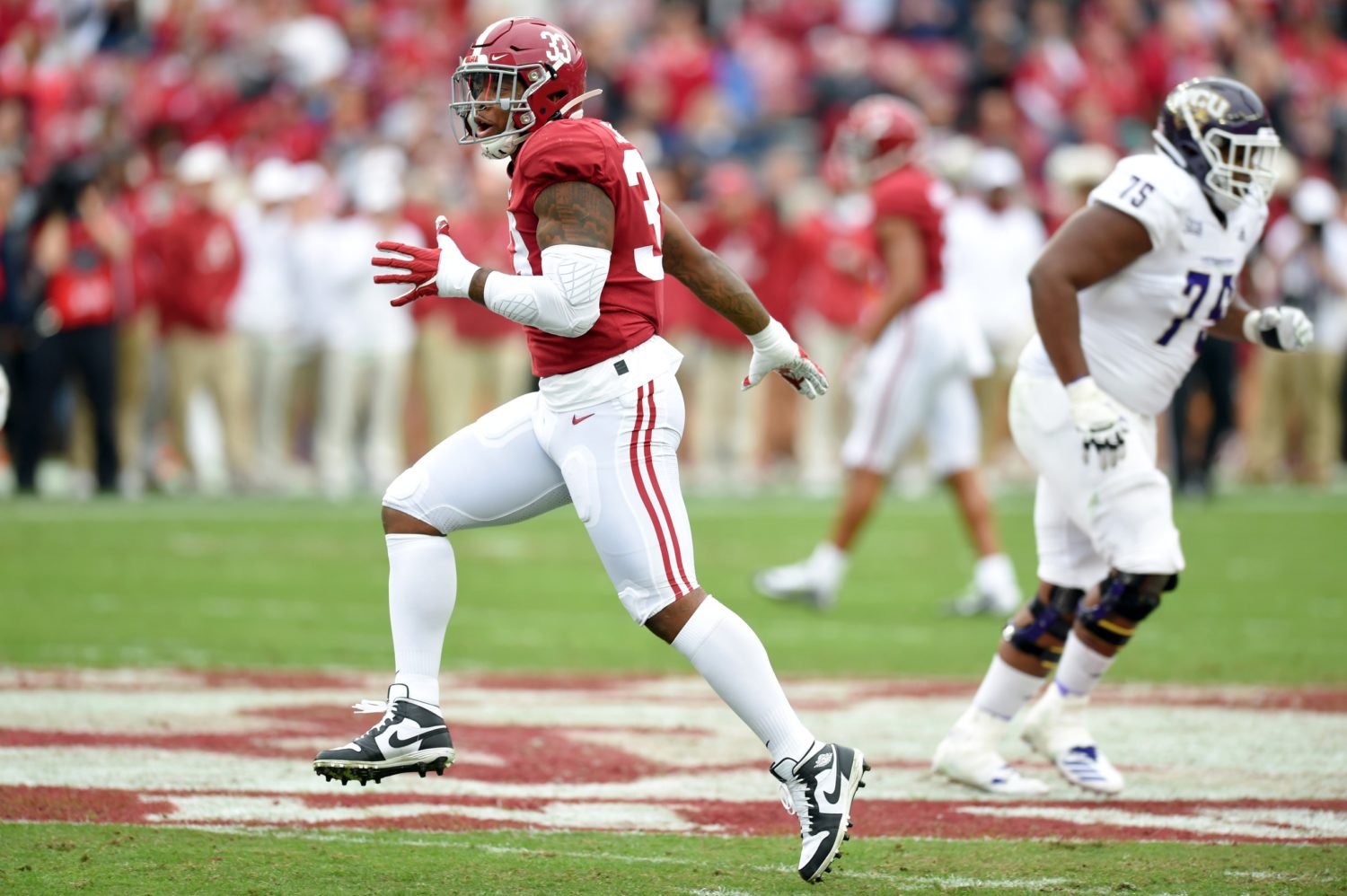
No, Tuesday didn’t reveal the only thing that ultimately matters. That is, the final Playoff poll.
Here’s the good news.
We now only have 1 more non-meaningful poll before the field is announced. That means we’re more than halfway finished with Tuesday night selection shows. Cheers to that.
But more important than the simple revealing is what the rankings mean and how we should look at them from a big-picture perspective. So why don’t we do that:
1. Should Ohio State really be ahead of LSU?
I don’t know how much it really matters at this juncture, but I think it’s a fun debate to dive into given how good their résumés are, especially after Ohio State’s win against Penn State moved the Buckeyes to No. 1 ahead of LSU.
Here’s a quick snapshot of what that probably looked like for the selection committee before they decided on their ranking for Tuesday:
[table “” not found /]And it’s worth noting that all of Ohio State’s wins vs. current Playoff Top 25 teams came by double digits whereas 2 of LSU’s 3 came by single digits (and Florida probably should have).
CFP selection chairman Rob Mullens said of Ohio State that “it’s probably that complete team piece. Ohio State has been very good on both sides of the ball.” In other words, LSU’s defense is holding it back from getting the style points that the Buckeyes’ top-ranked scoring defense continues to rack up.
Has Ohio State played a game on the road at a place like Alabama yet? Absolutely not. Not even winning at Michigan would be on that level.
Still, though. This discussion is going to become increasingly interesting because Ohio State obviously ends the season with Michigan and the Minnesota/Wisconsin winner. Both of them are ranked, and both of them are away from home. LSU, on the other hand, only has 1 more chance to pick up a win against a ranked foe, albeit against a battle-tested Georgia squad.
This battle for No. 1 could shape the matchup for who draws Clemson in the semifinal, which I can’t imagine anyone would want at this point. I’ll have to break down the LSU-Ohio State discussion after each remaining selection show moving forward.
2. The impact of Cupcake Week for Alabama was something … I think
In the current rankings, Cupcake Week meant nothing for Alabama.
There wasn’t much of a surprise that Alabama stayed at No. 5. Utah wasn’t going to pass Alabama for beating 4-win Arizona, and Oklahoma didn’t exactly make the case that it deserved a major bump after escaping 5-win TCU at home. And Minnesota, which still deserves more selection committee love, wasn’t going to get it for a 16-point victory against 2-win Northwestern. Of course, Oregon and Penn State losing wasn’t going to warrant a rise ahead of Alabama, either.
So yeah, it’s easy to justify keeping Alabama locked into that No. 5 spot. Nothing drastic changed in that regard.
Many will argue that it’s occurrences like that which make Cupcake Week passable. In the short term, yes. When there’s zero immediate punishment for that, that’s absolutely the case.
But consider this. What if Alabama had did what Clemson did and schedule not 1 but 2 Power 5 opponents in nonconference play? How much differently would we be talking about Alabama right now if instead of facing Western Carolina, it had Notre Dame?
Cupcake Week essentially eliminated a chance for Alabama to pick up a much-needed quality win. Even if that didn’t matter on Tuesday, it could definitely be a major factor on Selection Sunday (more on that later).
3. Why Georgia’s weekend wasn’t as underwhelming as you might’ve thought
Sure, that was a home game in which Georgia was nearly a 2-touchdown favorite. Winning by 6 points against unranked Texas A&M amidst some questionable officiating should’ve given the selection committee pause and they should’ve dropped the Dawgs, right?
Not so fast.
Here’s why Georgia’s case as a 1-loss team is as strong as ever. With the win against A&M, as well as Tennessee and Kentucky winning to clinch bowl eligibility, Georgia now has 6 wins against Power 5 teams with a winning record. That’s 2 more than the next-closest team with a Playoff path (Baylor, Clemson, LSU and Utah all have 4).
It’s strange because on the surface, one would think that the SEC East is a favorable path. But Georgia’s résumé continues to strengthen while a team like Alabama can’t find the quality wins. Teams like Florida, Notre Dame and Auburn remaining in the Playoff Top 25 certainly helps. The Dawgs are tied for the most wins (3) against teams ranked in the Playoff Top 25.
Because of those factors and the likely scenario that Georgia rolls past Georgia Tech, it’s hard to imagine a world in which Kirby Smart’s team would be anything worse than No. 4 heading into the SEC Championship.
4. Your numbers to know
As I always say here, I keep a running tally of these 3 metrics — wins vs. Power 5 teams with winning records, wins vs. teams in the current Playoff Top 25 and average margin of victory vs. Power 5 competition.
Here’s how each team with a Playoff path stacks up:
WINS VS. POWER 5 TEAMS WITH WINNING RECORDS
- Georgia: 6
- Baylor: 4
- Clemson: 4
- LSU: 4
- Utah: 4
- Oklahoma: 3
- Ohio State: 3
- Alabama: 2
- Minnesota: 2
WINS VS. TEAMS IN CURRENT PLAYOFF TOP 25
- Georgia: 3
- LSU: 3
- Ohio State: 3
- Oklahoma: 2
- Baylor: 1
- Minnesota: 1
- Alabama: 0
- Clemson: 0
- Utah: 0
AVERAGE MARGIN OF VICTORY VS. POWER 5 TEAMS
- Ohio State: +36.4
- Clemson: +33.3
- Alabama: +24.9
- Utah: +24.4
- Minnesota: +18.9
- LSU: +17.1
- Oklahoma: +16
- Georgia: +13.8
- Baylor: +7.8
Again, the Georgia résumé is still pretty darn good, despite those close wins.
What I find interesting? The Utah vs. Alabama numbers. Utah has twice as many wins against Power 5 teams with winning records, and in all likelihood, Utah is going to have just as many wins vs. current Top 25 teams as Alabama if it can win the Pac-12 Championship.
What’s also significant is the margin of victory vs. Power 5 teams. Though they have vastly different identities, Utah’s average margin of victory vs. Power 5 competition is just 0.5 less than Alabama’s. Utah has only played in 1 one-possession game since the Sept. 21 loss to 8-win USC.
Because one team would have a conference championship and one team wouldn’t, I’m not sure if this would come down to Alabama’s potential margin of victory vs. Auburn compared to Utah’s potential margin of victory vs. Oregon in the Pac-12 Championship. But those résumés are much, much closer than many people probably realize.
5. Let’s try predicting the Playoff field … again
Ok, so last week, I beefed up. I gave Oregon the kiss of death by predicting it would earn the No. 4 seed. So this week, I’m gonna take another stab at this.
Based on what we’ve seen from the selection committee, here’s what I think the top 4 will look like a week from Sunday:
- Ohio State
- LSU
- Clemson
- Oklahoma
That’s right. I think the Sooners will have a chance to earn that final spot over Utah for a couple reasons. Part of this is based on the simple résumé factor.
As it stands, Utah doesn’t have a win against a team that’s currently ranked in the Playoff Top 25. Oklahoma, of course, has the Baylor win. Oklahoma can close the season with 2 more wins against teams who are currently in the Top 25 (Oklahoma State and Baylor). That would give Oklahoma 3 wins against current Top 25 teams away from home.
In other words, Pac-12 parity is killing Utah’s résumé. The Oregon loss was another blow to it.
There’s something else that I keep coming back to. It has nothing to do with Oklahoma having the household name at quarterback with Jalen Hurts, or the fact that the Sooners made the field 3 times already.
It’s the fact that a Pac-12 title game that’s going to be played on Friday night isn’t going to have the last laugh. It’ll be the Big 12 Championship that gets the final statement. And no offense to the Pac-12 Championship, which is played at 5 p.m. local time in front of a sparse crowd, but it’s going to feel like a lot more is at stake on Saturday afternoon if Oklahoma and Baylor are facing off with 1 loss apiece.
Oklahoma, in my opinion, will have the more favorable path. Then again, that’s what I said about Oregon last week.
Connor O'Gara is the senior national columnist for Saturday Down South. He's a member of the Football Writers Association of America. After spending his entire life living in B1G country, he moved to the South in 2015.







